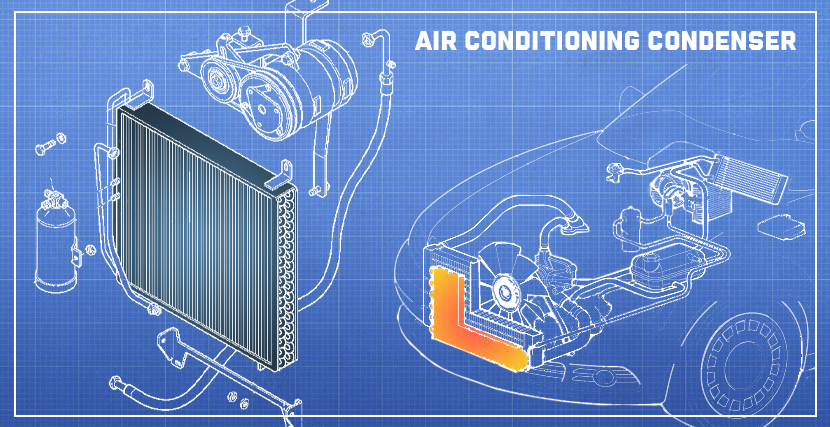Air Conditioning Condenser
Mounted in front of the vehicle just behind the grille, your air conditioning condenser does the same job as your radiator. But, instead of coolant it cools down the hot refrigerant that flows through the condenser and then returns into the system. Just like the radiator, it features a variety of tubes and fins, which, when exposed to oncoming air, help in reducing the refrigerant. As a result, the hot refrigerant inside the tubes is transformed into a liquid before it leaves the condenser. To increase the efficiency of the whole process, your condenser is equipped with an electrical fan that comes in handy when the vehicle is idling or moving slowly.

Your air conditioning condenser is a major component of a complex system that consists of many parts, each of which does its piece of job to reduce the temperature inside the cabin. The process starts with the liquid refrigerant that begins to boil when it enters the evaporator core. The boiling refrigerator expands, absorbing heat from the surrounding air. Since your blower motor forces hot air from the cabin through the evaporator fins, its temperature reduces and this cooled air is returned into the cabin. Then the hot gaseous refrigerant leaves the evaporator and moves into the compressor, which pressurizes it and pumps into the condenser. The latter cools the refrigerant and returns it into the system, so the cycle can be repeated.
Just like your radiator, the condenser can get damaged or clogged, causing a number of air conditioning system problems:
Your vents blow hot air
The condenser is responsible for removing heat from the refrigerant. Its failure or improper operation will make the air conditioning system to operate inefficiently.
Ice on the condenser
A clogged condenser can restrict the flow of refrigerant, collecting frost on its housing.
Leaks
A damaged or worn-out condenser can become a source of refrigerant leaks.
Blinking A/C button
If there is a problem with the air conditioning system, your A/C button can blink.
Excessive pressure in the air conditioning system
Increased compressor discharge pressure is usually caused by a clogged or restricted condenser. Your mechanic will need to use a pressure gauge to check the system.
Air conditioning condenser troubleshooting and replacement
In most cases, a bad air conditioning condenser is not repairable. It must be replaced with a brand-new unit. The replacement process will involve lots of labor and specific equipment to evacuate and recharge the A/C system. In many cases, the bumper, the front grille or the radiator must be replaced to access the condenser. The accumulator or receiver-drier should also be replaced to keep the system clean.
Since both replacing and diagnosing the air conditioning condenser require professional assistance and equipment, we recommend you to leave this job to a professional mechanic.